Comparison and Intercorrelation of Extraction Methods for Polyphenol Content and Antioxidant Capacity of Scab-Resistant Apple Cultivars
Abstract
:1. Introduction
2. Materials and Methods
2.1. Orchard Site and Sampled Apple Cultivars
2.2. Sample Preparation and Extraction Methods
2.2.1. Enzymatic Hydrolysis with Pectinase
2.2.2. Ethanol Extraction Methods
2.2.3. Methanol and Methanol + Acetone Extraction Methods
2.3. Measures for Polyphenol Content and Antioxidant Capacities
2.3.1. Total Polyphenol Content—TPC
2.3.2. Antioxidant Capacity Measured by FRAP
2.3.3. Antioxidant Capacity Measured by DPPH
2.3.4. Antioxidant Capacity Measured by TEAC
2.4. Statistical Analysis
2.4.1. Analyses of Variance—ANOVA
2.4.2. Correlation and Linear Regression Analyses among Parameters
3. Results
3.1. Total Polyphenol Content (TPC)
3.2. Antioxidant Capacity Measured with Ferric Reducing Ability of Plasma (AC-FRAP)
3.3. Antioxidant Capacity Measured with DPPH (AC-DPPH)
3.4. Antioxidant Capacity Measured with TEAC (AC-TEAC)
3.5. Relationship among Parameters
3.5.1. Pearson Correlation Analyses
3.5.2. Linear Regression Analyses
4. Discussion
5. Conclusions
- -
- TPC values were higher than the values of AC-FRAP, AC-DPPH, and AC-TEAC. In addition, values of AC-FRAP and AC-DPPH were generally higher than values of AC-TEAC for all extraction methods. Therefore, the methods used for TPC determination of resistant apples can be recommended over the other three methods.
- -
- Values of TPC, AC-FRAP, AC-DPPH, and AC-TEAC were significantly different among the six extraction methods. Values of TPC were generally the highest in the pectinase method and the lowest in ethanol solvent including a second phase extraction (EtOH-2). Our results suggest that the extraction method using the pectinase enzyme may provide the most stable yield of polyphenol content from samples of apple flesh, as confirmed by the examination of four cultivars.
- -
- This study confirmed that values of TPC, AC-FRAP, AC-DPPH, and AC-TEAC varied among the four resistant cultivars, and demonstrated that the antioxidant capacity of the four cultivars differed among extraction methods. These results suggest that the type of extraction method has to be taken into account when a cultivar is assessed for polyphenol content and/or antioxidant capacity.
- -
- Correlation and regression analyses conducted in this study suggest strong relationships between the pair-variables of TPC vs. AC-FRAP and AC-TEAC vs. AC-DPPH, indicating strong connections among extraction methods and the measured antioxidant capacity values.
Author Contributions
Funding
Data Availability Statement
Conflicts of Interest
References
- Fardet, A.; Boirie, Y. Associations between food and beverage groups and major diet-related chronic diseases: An exhaustive review of pooled/meta-analyses and systematic reviews. Nutr. Rev. 2014, 72, 741–762. [Google Scholar] [CrossRef] [PubMed]
- Hyson, D.A. A Comprehensive review of apples and apple components and their relationship to human health. Adv. Nutr. 2011, 2, 408–420. [Google Scholar] [CrossRef] [PubMed]
- Goulas, V.; Kourdoulas, P.; Makris, F.; Theodorou, M.; Fellman, J.K.; Manganaris, G.A. Comparative polyphenolic antioxidant profile and quality of traditional apple cultivars as affected by cold storage. Int. J. Food Sci. Technol. 2014, 49, 2037–2044. [Google Scholar] [CrossRef]
- Babbar, N.; Oberoi, H.S.; Sandhu, S.K. Therapeutic and nutraceutical potential of bioactive compounds extracted from fruit residues. Crit. Rev. Food Sci. Nutr. 2015, 55, 319–337. [Google Scholar] [CrossRef]
- Yassin, L.S.; Alberti, A.; Zielinski, A.A.F.; Emílio, H.R.O.; Nogueira, A. Cytoprotective effect of phenolic extract from Brazilian apple peel in insulin-producing cells. Curr. Nutr. Food Sci. 2017, 13, 136–142. [Google Scholar] [CrossRef]
- Da Silva, K.M.; Zielinski, A.A.F.; Benvenutti, L.; Bortolini, D.G.; Zardo, D.M.; Beltrame, F.L.; Nogueira, A.; Alberti, A. Effect of fruit ripening on bioactive compounds and antioxidant capacity of apple beverages. Food Sci. Technol. 2019, 39, 294–300. [Google Scholar] [CrossRef] [Green Version]
- Avci, A.; Atli, T.; Ergüder, İ.B.; Varlı, M.; Devrim, E.; Turgay, S.A.M.; Durak, İ. Effects of apple consumption on plasma and erythrocyte antioxidant parameters in elderly subjects. Exp. Aging Res. 2007, 33, 429–437. [Google Scholar] [CrossRef]
- Giaretta, A.G.; Schulz, M.; Silveira, T.T.; de Oliveira, M.V.; Patrício, M.J.; Gonzaga, L.V.; Fett, R.; da Silva, E.L.; Wazlawik, E. Apple intake improves antioxidant parameters in hemodialysis patients without affecting serum potassium levels. Nutr. Res. 2019, 64, 56–63. [Google Scholar] [CrossRef]
- Lee, K.W.; Kim, Y.J.; Kim, D.; Lee, H.J.; Lee, C.Y. Major phenolics in apple and their contribution to the total antioxidant capacity. J. Agric. Food Chem. 2003, 51, 6516–6520. [Google Scholar] [CrossRef]
- Tsao, R.; Yang, R.; Xie, S.; Sockovie, E.; Khanizadeh, S. Which polyphenolic compounds contribute to the total antioxidant activities of apple? J. Agric. Food Chem. 2005, 53, 4989–4995. [Google Scholar] [CrossRef]
- Wojdyło, A.; Oszmiański, J.; Laskowski, P. Polyphenolic compounds and antioxidant activity of new and old apple varieties. J. Agric. Food Chem. 2008, 56, 6520–6530. [Google Scholar] [CrossRef] [PubMed]
- Lata, B.; Trampczynska, A.; Paczesna, J. Cultivar variation in apple peel and whole fruit phenolic composition. Sci. Hortic. 2009, 121, 176–181. [Google Scholar] [CrossRef]
- Khanizadeh, S.; Tsao, R.; Rekika, D.; Yang, R.; Charles, M.T.; Rupasinghe, H.P.V. Polyphenol composition and total antioxidant capacity of selected apple genotypes for processing. J. Food Compos. Anal. 2008, 21, 396–401. [Google Scholar] [CrossRef]
- Kim, I.; Ku, K.H.; Jeong, M.C.; Kwon, S.I.; Lee, J. Metabolite profiling and antioxidant activity of 10 new early- to mid-season apple cultivars and 14 traditional cultivars. Antioxidants 2020, 9, 443. [Google Scholar] [CrossRef]
- Roginsky, Y.; Lissi, E.A. Review of methods to determine chain-breaking antioxidant activity in food. Food Chem. 2005, 92, 235–254. [Google Scholar] [CrossRef]
- Vieira, F.G.K.; Borges, G.D.S.C.; Copetti, C.; Di Pietro, P.F.; da Costa Nunes, E.; Fett, R. Phenolic compounds and antioxidant activity of the apple flesh and peel of eleven cultivars grown in Brazil. Sci. Hortic. 2011, 128, 261–266. [Google Scholar] [CrossRef]
- Bai, X.; Zhang, H.; Ren, S. Antioxidant activity and HPLC analysis of polyphenol-enriched extracts from industrial apple pomace. J. Sci. Food Agric. 2013, 93, 2502–2506. [Google Scholar] [CrossRef]
- Hobbi, P.; Okoro, O.V.; Delporte, C.; Alimoradi, H.; Podstawczyk, D.; Nie, L.; Shavandi, A. Kinetic modelling of the solid–liquid extraction process of polyphenolic compounds from apple pomace: Influence of solvent composition and temperature. Bioresour. Bioprocess. 2021, 8, 114. [Google Scholar] [CrossRef]
- Boyer, J.; Liu, R.H. Apple phytochemicals and their health benefits. Nutr. J. 2004, 3, 517S–520S. [Google Scholar] [CrossRef] [Green Version]
- Ferrari, C.K.; Percário, S.; Silva, J.C.; da Silva Torres, E.A. An apple plus a Brazil nut a day keeps the doctors away: Antioxidant capacity of foods and their health benefits. Curr. Pharmaceut. Des. 2016, 22, 189–195. [Google Scholar] [CrossRef]
- Treutter, D. Significance of flavonoids in plant resistance and enhancement of their biosynthesis. Plant Biol. 2005, 7, 581–591. [Google Scholar] [CrossRef]
- Petrovsek, M.M.; Stamper, F.; Veberic, R. Parameters of inner quality of the apple scab resistant and susceptible apple cultivars (Malus domestica Borkh.). Sci. Hortic. 2007, 114, 37–44. [Google Scholar] [CrossRef]
- Tóth, M.; Ficzek, G.; Király, I.; Kovács, S.; Hevesi, M.; Halász, J.; Szani, Z. ‘Artemisz’, ‘Cordelia’, ‘Hesztia’ and ‘Rosmerta’, new Hungarian multi-resistant apple cultivars. HortScience 2012, 42, 1795–1800. [Google Scholar] [CrossRef] [Green Version]
- Holb, I.J.; Dremák, P.; Bitskey, K.; Gonda, I. Yield response, pest damage and fruit quality parameters of scab-resistant and scab-susceptible apple cultivars in integrated and organic production systems. Sci. Hortic. 2012, 145, 109–117. [Google Scholar] [CrossRef]
- Holb, I.J. Classification of apple cultivar reactions to scab in integrated and organic production systems. Can. J. Plant Pathol. 2007, 29, 251–260. [Google Scholar] [CrossRef]
- Holb, I.J. Fungal disease management in environmentally friendly apple production—A review. Sustain. Agric. Rev. 2009, 2, 219–292. [Google Scholar]
- Holb, I.J. Timing of first and final sprays against apple scab combined with leaf removal and pruning in organic apple production. Crop Prot. 2008, 27, 814–822. [Google Scholar] [CrossRef]
- Holb, I.J.; Abonyi, F.; Buurma, J.; Heijne, B. On-farm and on-station evaluations of three orchard management approaches against apple scab and apple powdery mildew. Crop Prot. 2017, 97, 109–118. [Google Scholar] [CrossRef]
- Brown, S.K.; Maloney, K.E. An update on apple cultivars, brands and club-marketing. N. Y. Fruit Q. 2013, 21, 3–10. [Google Scholar]
- Nuzzi, M.; Bianchi, G.; Lovati, F.; Grassi, M.; Buccheri, M. Long-term storage and controlled atmosphere affect antioxidant properties and sensory quality of new ’Gala’-type apple cultivars. Acta Hortic. 2015, 1071, 355–364. [Google Scholar] [CrossRef]
- Chitarrini, G.; Dordevic, N.; Guerra, W.; Robatscher, P.; Lozano, L. Aroma investigation of new and standard apple varieties grown at two altitudes using gas chromatography-mass spectrometry combined with sensory analysis. Molecules 2020, 25, 3007. [Google Scholar] [CrossRef] [PubMed]
- Li, W.; Yang, R.; Ying, D.; Yu, J.; Sanguansri, L.; Augustin, M.A. Analysis of polyphenols in apple pomace: A comparative study of different extraction and hydrolysis procedures. Ind. Crops Prod. 2020, 4, 112. [Google Scholar] [CrossRef]
- Shahidi, F.; Yeo, J.D. Insoluble-bound phenolics in food. Molecules 2016, 21, 1216. [Google Scholar] [CrossRef] [PubMed]
- Kun-Nemes, A.; Szőllősi, E.; Stündl, L.; Biró, A.; Homoki, J.; Szarvas, M.; Balogh, P.; Cziáky, Z.; Gálné Remenyik, J. Determination of flavonoid and proanthocyanidin profile of Hungarian sour cherry. Molecules 2018, 23, 3278. [Google Scholar] [CrossRef] [PubMed] [Green Version]
- Jakab, A. The ammonium lactate soluble potassium and phosphorus content of the soils of north-east Hungary region: A quantifying study. DRC Sustain. Future 2020, 1, 10. [Google Scholar] [CrossRef] [Green Version]
- Saura-Calixto, F.; Goñi, I. Antioxidant capacity of the Spanish Mediterranean diet. Food Chem. 2006, 94, 442–447. [Google Scholar] [CrossRef]
- Singleton, V.L.; Orthofer, R.; Lamuela-Raventós, R.M. Analysis of total phenols and other oxidation substrates and antioxidants by means of folin-ciocalteu reagent. Methods Enzymol. 1999, 299, 152–178. [Google Scholar]
- Huang, D.J.; Ou, B.X.; Prior, R.L. The chemistry behind antioxidant capacity assays. J. Agric. Food Chem. 2005, 53, 1841–1856. [Google Scholar] [CrossRef]
- Benzie, I.F.; Strain, J.J. The ferric reducing ability of plasma (FRAP) as a measure of “antioxidant power”: The FRAP assay. Anal. Biochem. 1996, 239, 70–76. [Google Scholar] [CrossRef] [Green Version]
- Blois, M.S. Antioxidant determinations by the use of a stable free radical. Nature 1958, 181, 1199–1200. [Google Scholar] [CrossRef]
- Brand-Williams, W.; Cuvelier, M.E.; Berset, C. Use of a free radical method to evaluate antioxidant activity. Food Sci. Technol. 1995, 28, 25–30. [Google Scholar] [CrossRef]
- Stratil, P.; Klejdus, B.; Kubáň, V. Determination of phenolic compounds and their antioxidant activity in fruits and cereals. Talanta 2007, 71, 1741–1751. [Google Scholar] [CrossRef] [PubMed]
- Miller, N.J.; Rice-Evans, C.A.; Davies, M.J.; Gopinathan, V.; Milner, A. A novel method for measuring antioxidant capacity and its application to monitoring the antioxidant status in premature neonates. Clin. Sci. 1993, 84, 407–412. [Google Scholar] [CrossRef] [PubMed] [Green Version]
- Re, R.; Pellegrini, N.; Proteggente, A.; Pannala, A.; Yang, M.; Rice-Evans, C. Antioxidant activity applying an improved ABTS radical cation decolorization assay. Free Radic. Biol. Med. 1999, 26, 1231–1237. [Google Scholar] [CrossRef]
- Zulueta, A.; Esteve, M.J.; Frígola, A. ORAC and TEAC assays comparison to measure the antioxidant capacity of food products. Food Chem. 2009, 114, 310–316. [Google Scholar] [CrossRef]
- Reis, S.F.; Rai, D.K.; Abu-Ghannam, N. Water at room temperature as a solvent for the extraction of apple pomace phenolic compounds. Food Chem. 2012, 135, 1991–1998. [Google Scholar] [CrossRef] [PubMed] [Green Version]
- Zardo, D.M.; Alberti, A.; Zielinski, A.A.F.; Prestes, A.A.; Esmerino, L.A.; Nogueira, A. Influence of solvents in the extraction of phenolic compounds with antibacterial activity from apple pomace. Sep. Sci. Technol. 2020, 56, 903–911. [Google Scholar] [CrossRef]
- Wijngaard, H.H.; Brunton, N. The optimisation of solid–liquid extraction of antioxidants from apple pomace by response surface methodology. J. Food Eng. 2020, 96, 134–140. [Google Scholar] [CrossRef]
- Rodriguez De Luna, S.L.; Ramirez-Garza, R.E.; Serna Saldivar, S.O. Environmentally friendly methods for favonoid extraction from plant material: Impact of their operating conditions on yield and antioxidant properties. Sci. World J. 2020, 12, 69. [Google Scholar] [CrossRef]
- Gliszczynska-Swiglo, A.; Tyrakowska, B. Quality of commercial apple juices evaluated on the basis of the polyphenol content and the TEAC antioxidant activity. J. Food Sci. 2003, 68, 1844–1849. [Google Scholar] [CrossRef]
- Davey, M.W.; Keulemans, J. Determining the potential to breed for enhanced antioxidant status in Malus: Mean inter- and intravarietal fruit vitamin C and glutathione contents at harvest and their evolution during storage. J. Agric. Food Chem. 2004, 52, 8031–8038. [Google Scholar] [CrossRef] [PubMed]
- Wolfe, K.; Wu, X.Z.; Liu, R.H. Antioxidant activity of apple peels. J. Agric. Food Chem. 2003, 51, 609–614. [Google Scholar] [CrossRef] [PubMed]
- Schmitz-Eiberger, M.; Weber, V.; Treutter, D.; Baab, G.; Lorenz, J. Bioactive components in fruits from different apple varieties. J. Appl. Bot. 2003, 77, 167–171. [Google Scholar]
- McGhie, T.K.; Hunt, M.; Barnet, L.E. Cultivar and growing region determine the antioxidant polyphenolic concentration and composition of apples grown in New Zealand. J. Agric. Food Chem. 2005, 53, 3065–3070. [Google Scholar] [CrossRef]
- Lachman, J.; Šulc, M.; Sus, J.; Pavlíková, O. Polyphenol content and antiradical activity in different apple varieties. Hortic. Sci. 2006, 33, 95–102. [Google Scholar] [CrossRef] [Green Version]
- Scalzo, J.; Politi, A.; Pellegrini, N.; Mezzetti, B.; Battino, M. Plant genotype affects total antioxidant capacity and phenolic contents in fruit. Nutrition 2005, 21, 207–213. [Google Scholar] [CrossRef]
- Drogoudi, P.D.; Michailidis, Z.; Pantelidis, G. Peel and flesh antioxidant content and harvest quality characteristics of seven apple cultivars. Sci. Hortic. 2008, 115, 149–153. [Google Scholar] [CrossRef]
- Vieira, F.G.K.; Borges, G.S.C.; Copetti, C.; Amboni, R.D.M.C.; Denardi, F.; Fett, R. Physico-chemical and antioxidant properties of six apple cultivars (Malus domestica Borkh) grown in southern Brazil. Sci. Hortic. 2009, 122, 421–425. [Google Scholar] [CrossRef]
- Leccese, A.; Bartolini, S.; Viti, R. Antioxidant properties of peel and flesh in ‘Gold Rush’ and ‘Fiorina’ scab-resistant apple (Malus domestica) cultivars. N. Z. J. Crop Hortic. Sci. 2009, 37, 71–78. [Google Scholar] [CrossRef]
- Pirlak, L.; Ünüvar, G.; Ersoy, N. Determination of antioxidant activities of some apple cultivars. Hortic. Sci. 2017, 44, 120–125. [Google Scholar] [CrossRef] [Green Version]
- Krisch, J.; Vucseta, K. Antioxidant properties of different apple cultivars. Rev. Agric. Rural Dev. 2018, 7, 23–26. [Google Scholar] [CrossRef]
- Kschonsek, J.; Wolfram, T.; Stöckl, A.; Böhm, V. Polyphenolic compounds analysis of old and new apple cultivars and contribution of polyphenolic profile to the in vitro antioxidant capacity. Antioxidants 2018, 7, 20. [Google Scholar] [CrossRef] [PubMed] [Green Version]
- Raudone, L.; Raudonis, R.; Liaudanskas, M.; Janulis, V.; Viskelis, P. Phenolic antioxidant profiles in the whole fruit, flesh and peel of apple cultivars grown in Lithuania. Sci. Hortic. 2017, 216, 186–192. [Google Scholar] [CrossRef]
- Vrhovsek, U.; Rigo, A.; Tonon, D.; Mattivi, F. Quantitation of polyphenols in different apple varieties. J. Agric. Food Chem. 2004, 52, 6532–6538. [Google Scholar] [CrossRef] [PubMed]
- Leja, M.; Mareczek, A.; Ben, J. Antioxidant properties of two apple cultivars during long-term storage. Food Chem. 2003, 80, 303–307. [Google Scholar] [CrossRef]
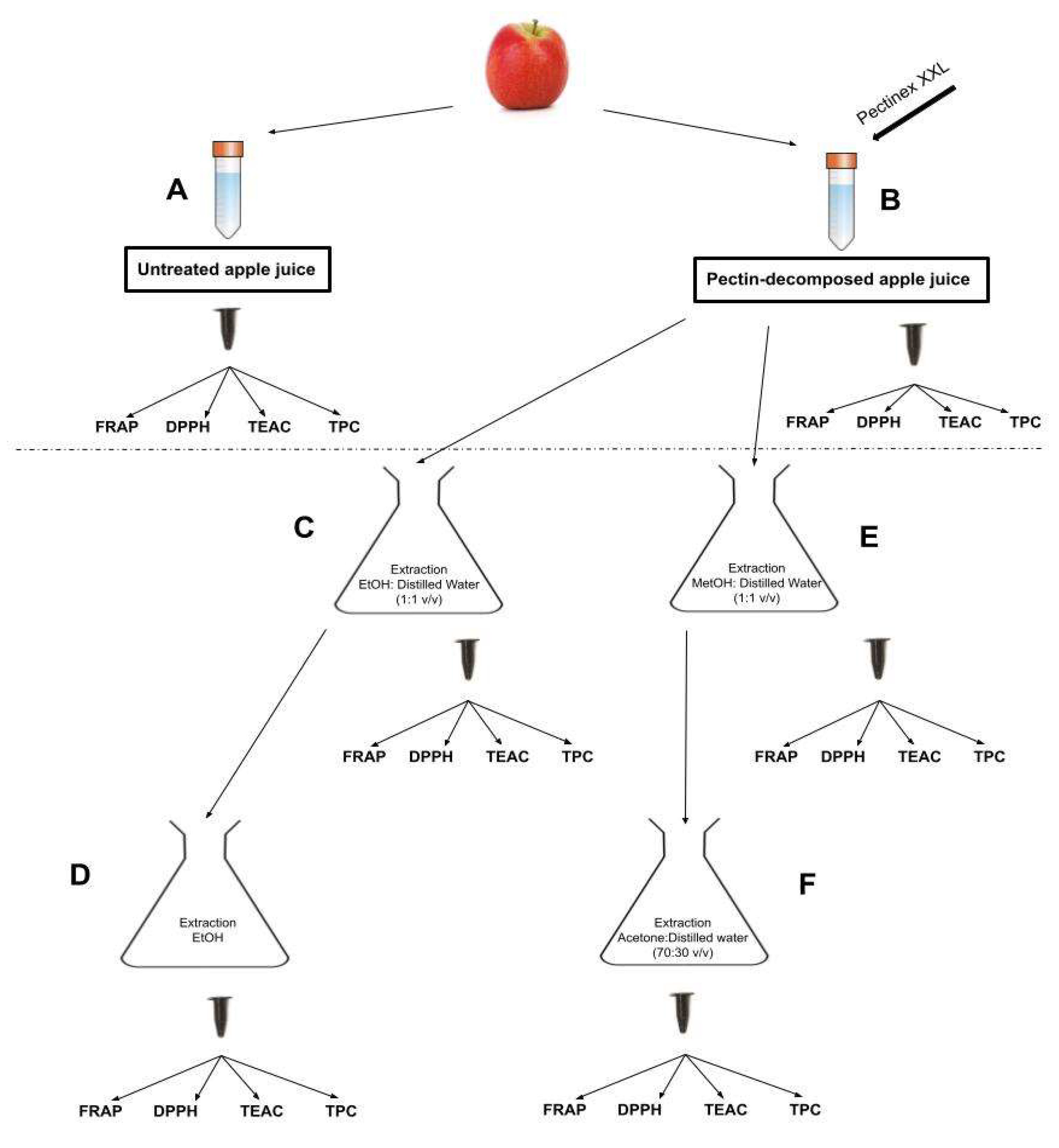
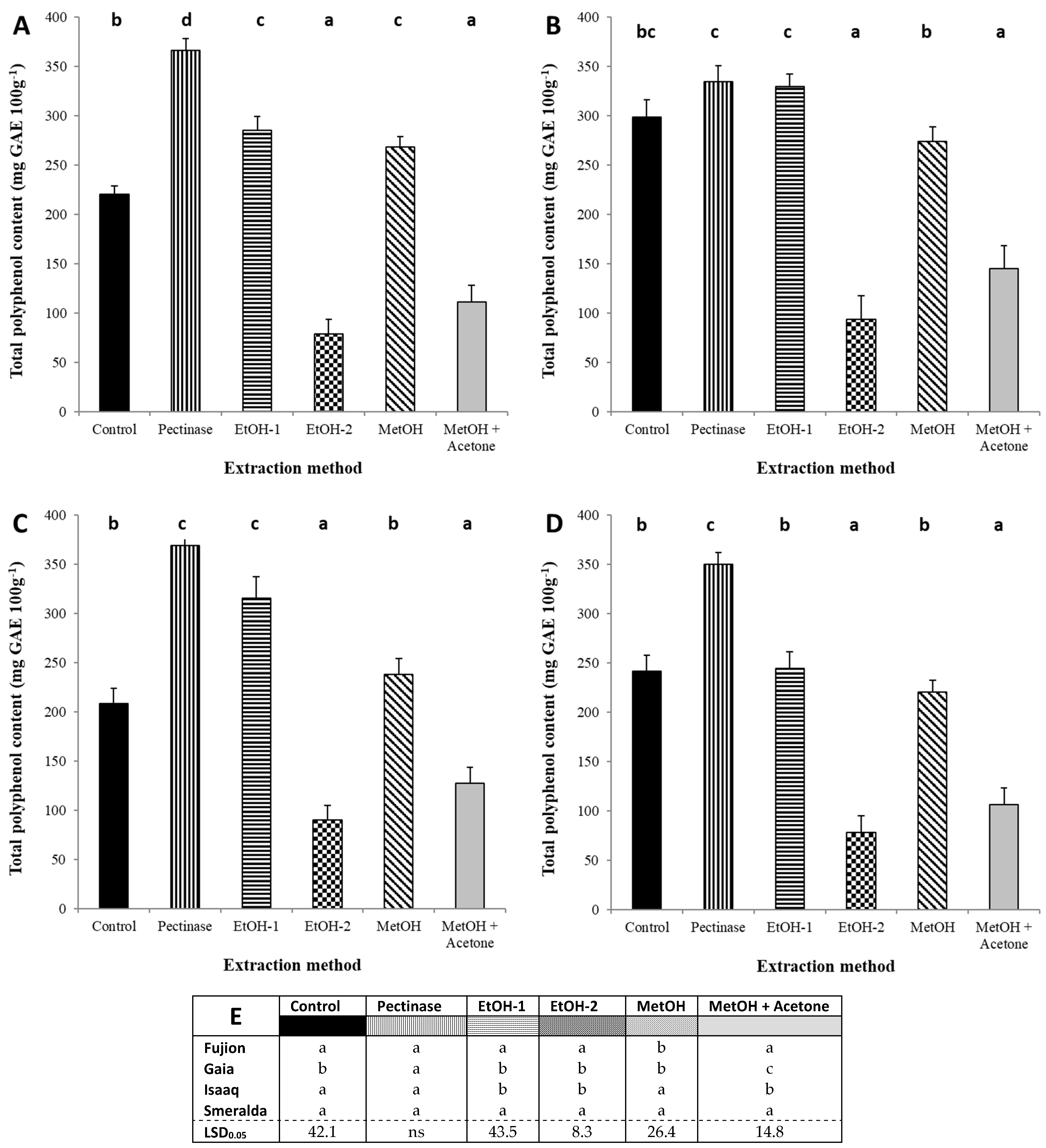
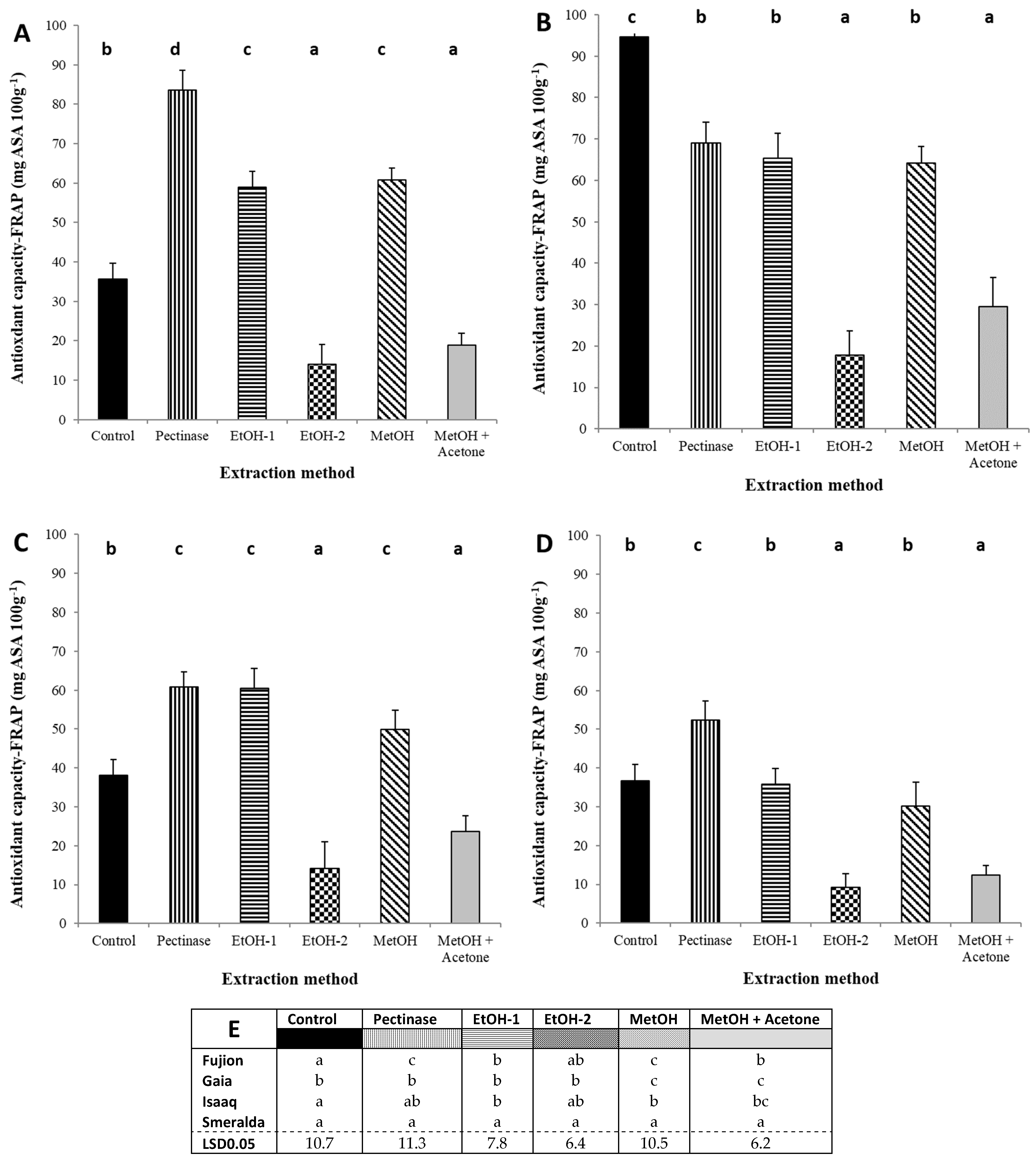
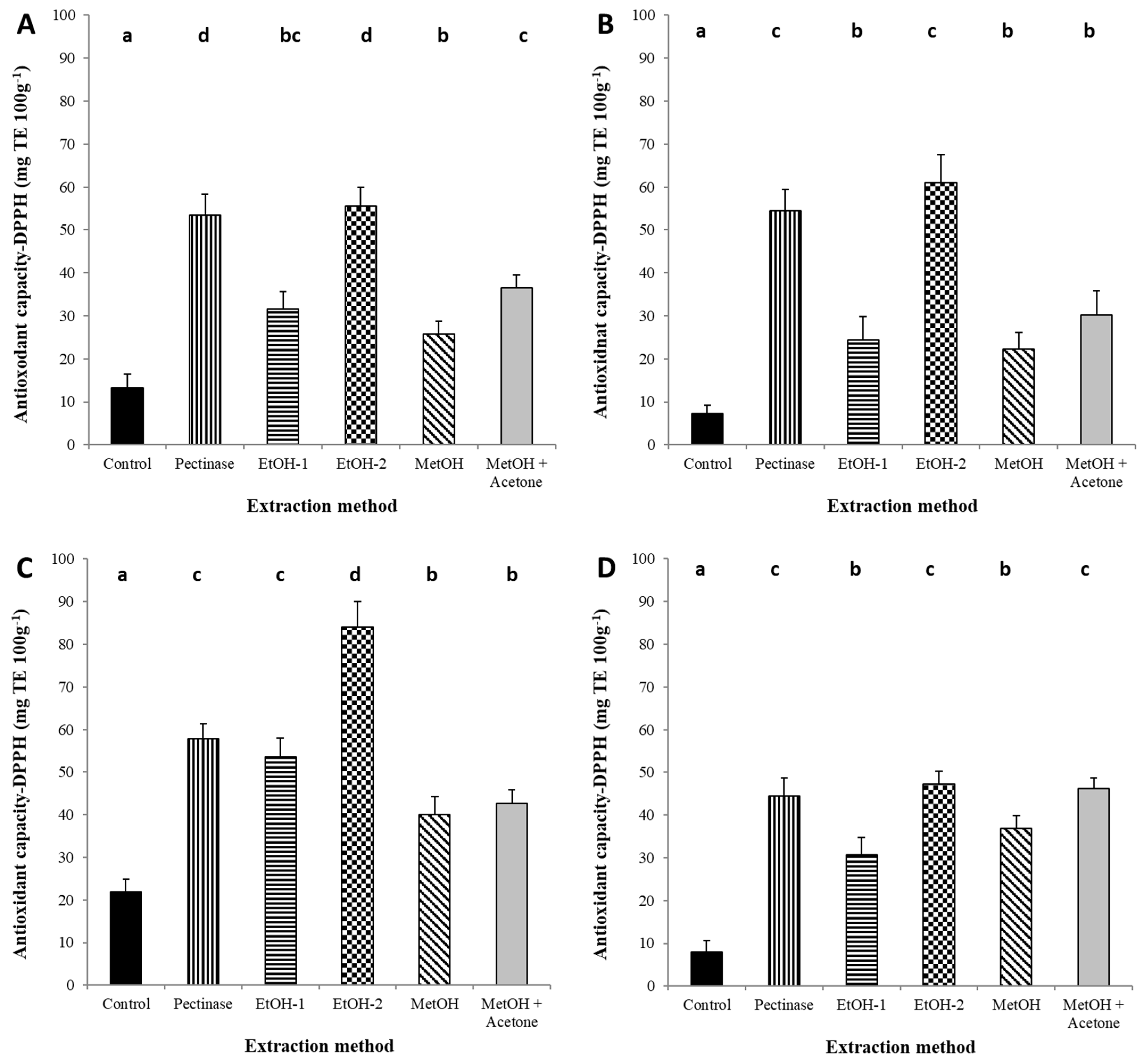

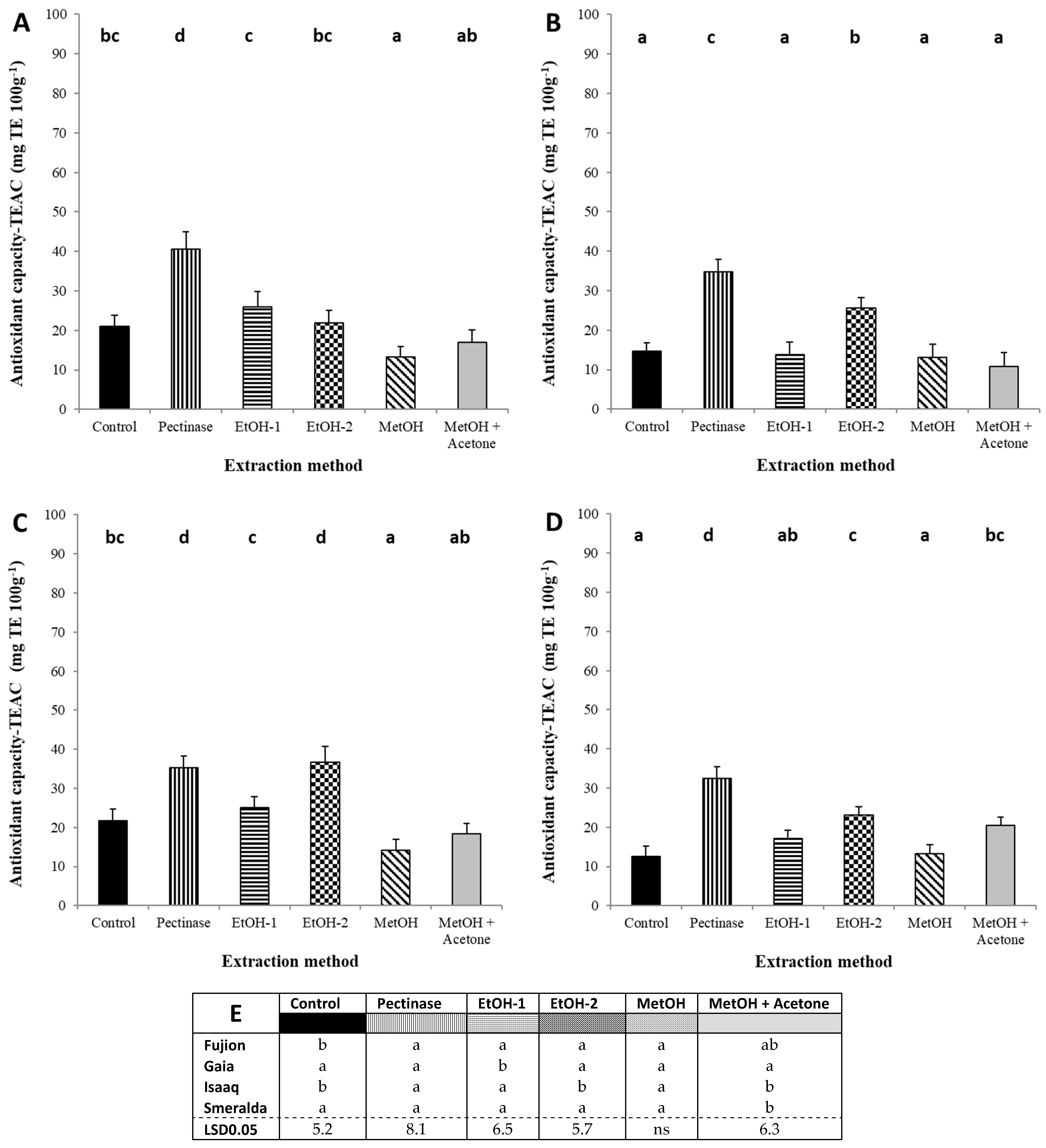
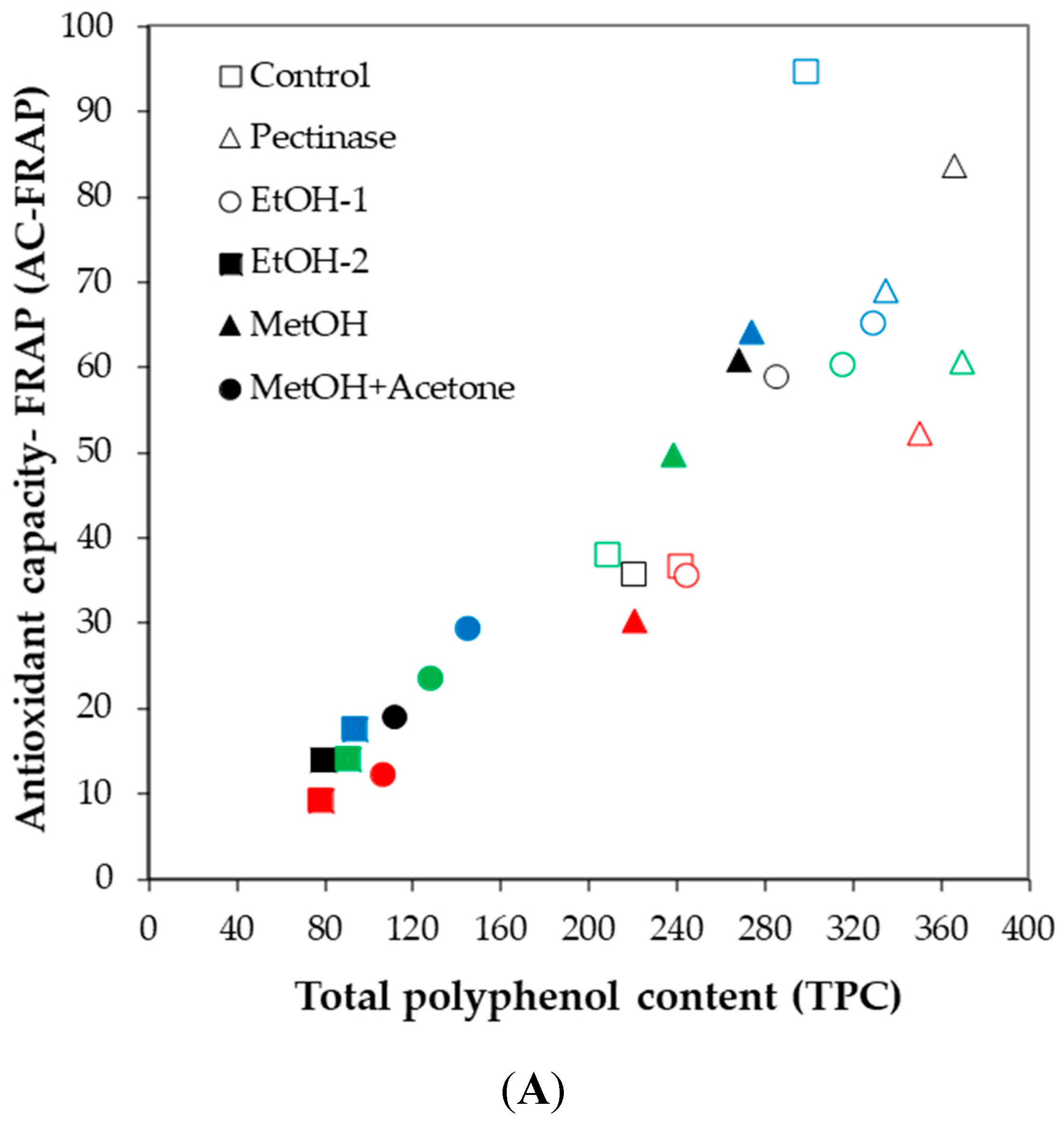
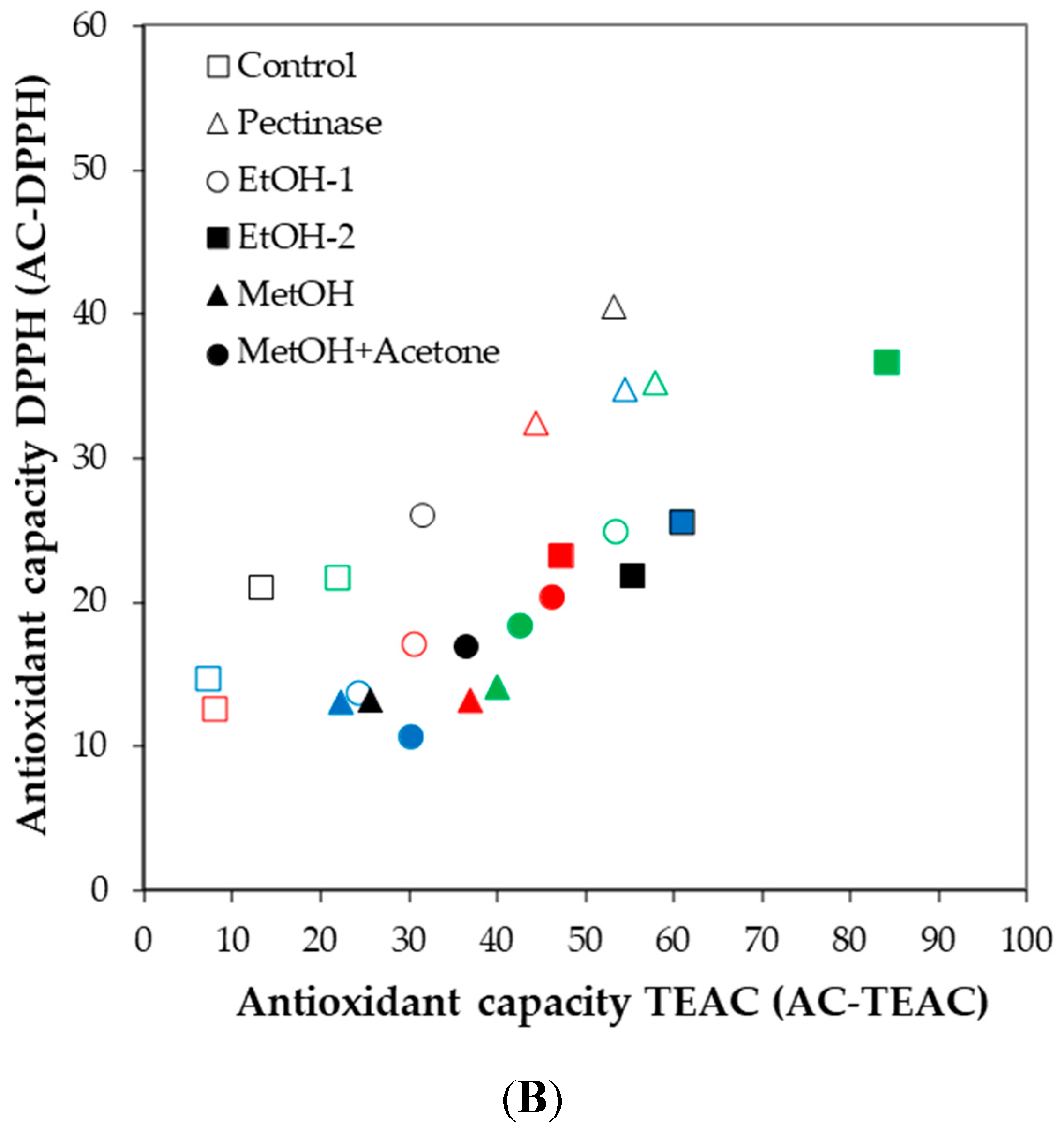
| Variance Sources | df | TPC | AC-FRAP | AC-DPPH | AC-TEAC | ||||
|---|---|---|---|---|---|---|---|---|---|
| MS | p | MS | p | MS | p | MS | p | ||
| Extraction method (E) | 5 | 2548.8 | 0.0491 | 764.2 | 0.0111 | 348.5 | 0.0047 | 53.4 | 0.0441 |
| Cultivar (C) | 3 | 42,071 | <0.001 | 1733.4 | <0.001 | 1184.6 | <0.001 | 268.6 | <0.001 |
| E × C | 15 | 541.9 | 0.3528 | 145.2 | 0.1831 | 52.9 | 0.1063 | 15.5 | 0.3148 |
| Error | 18 | 8129.3 | 2177.6 | 793.3 | 3824.1 | ||||
| Total | 23 | ||||||||
| Control | TPC | AC-FRAP | AC-DPPH |
| AC-FRAP | 0.9330 | ||
| AC-DPPH | −0.7808 | −0.5136 | |
| AC-TEAC | −0.6862 | −0.4063 | 0.8639 |
| Pectinase | TPC | AC-FRAP | AC-DPPH |
| AC-FRAP | 0.9439 | ||
| AC-DPPH | 0.3055 | 0.4507 | |
| AC-TEAC | 0.5054 | 0.1979 | 0.6575 |
| EtOH-1 | TPC | AC-FRAP | AC-DPPH |
| AC-FRAP | 0.9434 | ||
| AC-DPPH | 0.1818 | 0.1188 | |
| AC-TEAC | −0.0330 | 0.1733 | 0.6597 |
| EtOH-2 | TPC | AC-FRAP | AC-DPPH |
| AC-FRAP | 0.8033 | ||
| AC-DPPH | 0.6667 | 0.4113 | |
| AC-TEAC | 0.5994 | 0.1854 | 0.9523 |
| MetOH | TPC | AC-FRAP | AC-DPPH |
| AC-FRAP | 0.9665 | ||
| AC-DPPH | −0.9022 | −0.7637 | |
| AC-TEAC | −0.4171 | −0.1711 | 0.7658 |
| MetOH + Acetone | TPC | AC-FRAP | AC-DPPH |
| AC-FRAP | 0.9667 | ||
| AC-DPPH | −0.6259 | −0.64966 | |
| AC-TEAC | −0.8596 | −0.8671 | 0.9608 |
Publisher’s Note: MDPI stays neutral with regard to jurisdictional claims in published maps and institutional affiliations. |
© 2022 by the authors. Licensee MDPI, Basel, Switzerland. This article is an open access article distributed under the terms and conditions of the Creative Commons Attribution (CC BY) license (https://creativecommons.org/licenses/by/4.0/).
Share and Cite
Orosz-Tóth, M.; Nemes-Kun, A.; Lowy, D.A.; Csihon, Á.; Sándor, Z.; Kincses, I.; Holb, I.J. Comparison and Intercorrelation of Extraction Methods for Polyphenol Content and Antioxidant Capacity of Scab-Resistant Apple Cultivars. Agronomy 2022, 12, 289. https://doi.org/10.3390/agronomy12020289
Orosz-Tóth M, Nemes-Kun A, Lowy DA, Csihon Á, Sándor Z, Kincses I, Holb IJ. Comparison and Intercorrelation of Extraction Methods for Polyphenol Content and Antioxidant Capacity of Scab-Resistant Apple Cultivars. Agronomy. 2022; 12(2):289. https://doi.org/10.3390/agronomy12020289
Chicago/Turabian StyleOrosz-Tóth, Mihály, Andrea Nemes-Kun, Daniel A. Lowy, Ádám Csihon, Zsolt Sándor, Ida Kincses, and Imre J. Holb. 2022. "Comparison and Intercorrelation of Extraction Methods for Polyphenol Content and Antioxidant Capacity of Scab-Resistant Apple Cultivars" Agronomy 12, no. 2: 289. https://doi.org/10.3390/agronomy12020289
APA StyleOrosz-Tóth, M., Nemes-Kun, A., Lowy, D. A., Csihon, Á., Sándor, Z., Kincses, I., & Holb, I. J. (2022). Comparison and Intercorrelation of Extraction Methods for Polyphenol Content and Antioxidant Capacity of Scab-Resistant Apple Cultivars. Agronomy, 12(2), 289. https://doi.org/10.3390/agronomy12020289







